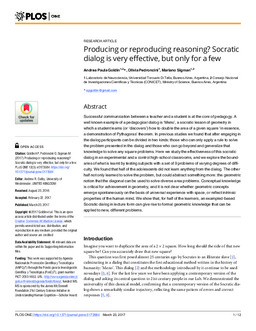| dc.rights.license | https://creativecommons.org/licenses/by/4.0/ | es_AR |
| dc.contributor.author | Goldin, Andrea Paula | es_AR |
| dc.contributor.author | Pedroncini, Olivia | es_AR |
| dc.contributor.author | Sigman, Mariano | es_AR |
| dc.date.accessioned | 2018-07-20T20:01:34Z | |
| dc.date.available | 2018-07-20T20:01:34Z | |
| dc.date.issued | 2017-03-23 | |
| dc.identifier | doi: 10.1371/journal.pone.0173584 | es_AR |
| dc.identifier.uri | https://doi.org/10.1371/journal.pone.0173584 | es_AR |
| dc.identifier.uri | https://repositorio.utdt.edu/handle/20.500.13098/11063 | |
| dc.description.abstract | Successful communication between a teacher and a student is at the core of pedagogy. A
well known example of a pedagogical dialog is `Meno', a socratic lesson of geometry in
which a student learns (or `discovers') how to double the area of a given square `in essence,
a demonstration of Pythagoras' theorem. In previous studies we found that after engaging in
the dialog participants can be divided in two kinds: those who can only apply a rule to solve
the problem presented in the dialog and those who can go beyond and generalize that
knowledge to solve any square problems. Here we study the effectiveness of this socratic
dialog in an experimental and a control high-school classrooms, and we explore the boundaries
of what is learnt by testing subjects with a set of 9 problems of varying degrees of difficulty.
We found that half of the adolescents did not learn anything from the dialog. The other
half not only learned to solve the problem, but could abstract something more: the geometric
notion that the diagonal can be used to solve diverse area problems. Conceptual knowledge
is critical for achievement in geometry, and it is not clear whether geometric concepts
emerge spontaneously on the basis of universal experience with space, or reflect intrinsic
properties of the human mind. We show that, for half of the learners, an exampled-based
Socratic dialog in lecture form can give rise to formal geometric knowledge that can be
applied to new, different problems. | es_AR |
| dc.format.extent | 12 p. | es_AR |
| dc.format.medium | application/pdf | es_AR |
| dc.language | eng | es_AR |
| dc.relation.ispartof | PLoS ONE 12(3): e0173584. | es_AR |
| dc.rights | info:eu-repo/semantics/openAccess | es_AR |
| dc.subject | Aprendizaje | es_AR |
| dc.subject | Comunicación | es_AR |
| dc.subject | Habla | es_AR |
| dc.subject | Geometría | es_AR |
| dc.title | Producing or reproducing reasoning? Socratic dialog is very effective, but only for a few | es_AR |
| dc.type | info:eu-repo/semantics/article | es_AR |
| dc.type.version | info:eu-repo/semantics/publishedVersion | es_AR |
| dc.description.filiation | Fil: Goldin, Andrea Paula. Universidad Torcuato Di Tella, Escuela de Negocios, Laboratorio de Neurociencia, Buenos Aires, Argentina. Consejo Nacional de Investigaciones Científicas y Técnicas (CONICET), Ministry of Science, Buenos Aires, Argentina | es_AR |
| dc.description.filiation | Fil: Pedroncini, Olivia. Universidad Torcuato Di Tella, Escuela de Negocios, Laboratorio de Neurociencia, Buenos Aires, Argentina | es_AR |
| dc.description.filiation | Fil: Sigman, Mariano. Universidad Torcuato Di Tella, Escuela de Negocios, Laboratorio de Neurociencia, Buenos Aires, Argentina. Consejo Nacional de Investigaciones Científicas y Técnicas (CONICET), Ministry of Science, Buenos Aires, Argentina | es_AR |

